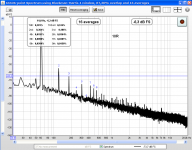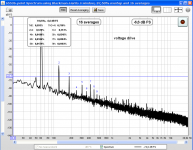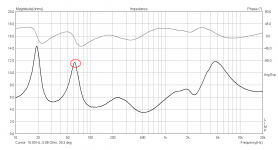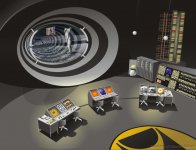Based on impedance plot, looks like ported enclosure. I would guess that IM for mix of spectral components in 20-500Hz range is messy.
Do you mean damp, or attenuate the tweeeter ?.The value of each is app 1 ohm parallel with 10 ohm film. the tweeters DC resistance is 8 ohm, so the resistors damp the response a little.
On the contrary, your input is most welcome....and I did ask.This is not the forum for speakers and normally I refrain from commenting on speakers here on DIY. So please forgive from writing a little about the Raidho tweeter.
Troels Graveson documents a TL kit incorporating the Raidho tweeter.The tweeter is where Raidho started app 15 years ago, it has in principle remained unchanged since then. it has been optimized in the membrane for lighter and thinner materials and a revised conductor pattern. The surface area is app like 3 domes, but the wight is less than 0.02g, which is 30-50 times less than a normal dome assembly, it is driven over the entire surface. With the extremely low weight and conductor pattern comes a heap of befits over all types of domes, mainly the absence of mass and mass/spring induced resonances, (30-50 times less) an incredible rise time. As the membrane is sealed around the edges, it does not suffer from the non solid performance in the lower working ranges like normal end-hung ribbons does, This makes it possible to integrate it with normal cone based drivers (if they are sufficiently low in noise).
What is the price and availability of this very well regarded tweeter ?
Rod Elliot has discussion about series crossovers - ESP - Series vs. Parallel Crossover NetworksOne huge advantage is also the absence of the normal low frequency resonance. this makes it possible (not so problematic) to use serial current diversion crossovers which are used through the Raidho C-D series of speakers.
Dan.
Another very good text is Doug Self's book on active corssover networks. There is a section on the comparison between parallel and series types of Saleen-Key type networks. A very good read if you have not read this book.
No two parallel resistors,
Mike
Thank you for replying.
one to avoid possible resonances and one (the wirewound) to set the value
I am sure you know that resistors in a (possibly formed) tank circuit can only act as dissipative elements reducing the Q of the circuit.
OOhh and the Diamond layer is on the membranes. 🙂 as to have a very very stiff membrane.
All right. That’s a good place for investing in diamonds (*)
sp3 solely, no sp2 bonds? 😉
The value of each is app 1 ohm parallel with 10 ohm film. the tweeters DC resistance is 8 ohm, so the resistors damp the response a little.
Now this is a perfectly clear (moebiusless) description. Two 0.9 Ohm non-reactive resistors in series with the 8 Ohm partly reactive tweeter. They surely lower and broaden the resonance peak
This is not the forum for speakers and normally I refrain from commenting on speakers here on DIY. So please forgive from writing a little about the Raidho tweeter.
We enjoy technical details. Besides, you were asked to inform us
One huge advantage is also the absence of the normal low frequency resonance. this makes it possible (not so problematic) to use serial current diversion crossovers which are used through the Raidho C-D series of speakers.
The open back construction places the already damped resonance much lower in frequency, that’s very good.
George
(*) My reference to gem stone in my previous post was tongue-in-cheek.
I hope you don’t really support anything from the Moebius coils (what a make-up) paraphernalia.
Mike
George
(*) My reference to gem stone in my previous post was tongue-in-cheek.
I hope you don’t really support anything from the Moebius coils (what a make-up) paraphernalia.
George, applied to audio there's a gold mine here. Mobius Coil Tutorial
Succor Punch, a new one I love it.
About 8-10 years ago, the tweeters were sold, tries made a kit, but sorry the tweeter is only for Raidho use.
The main advantages of current diversion (serial) filters are that changes in the bass driver at large amplitudes is reflected in the tweeter and the fact in the crossover band the drivers share current and as such they are phase locked to each other, also under high woul me transients, this makes the soundstage much less nervous and makes the"picture" better rendered with more and sharper contrasts.
Also some SP-2 bonds,<45%, this is the reason why the color is blackish. On a 41/2" membrane, there's something like 1,7 carat worth of diamond, but I suspect not the kind of gift you'd prsent to your girlfriend..🙂
The main advantages of current diversion (serial) filters are that changes in the bass driver at large amplitudes is reflected in the tweeter and the fact in the crossover band the drivers share current and as such they are phase locked to each other, also under high woul me transients, this makes the soundstage much less nervous and makes the"picture" better rendered with more and sharper contrasts.
Also some SP-2 bonds,<45%, this is the reason why the color is blackish. On a 41/2" membrane, there's something like 1,7 carat worth of diamond, but I suspect not the kind of gift you'd prsent to your girlfriend..🙂
Last edited:
I still remember the first time I saw someone in a restaurant waving a crystal pendant over their meal to see if it was good to eat!
"I was given the design for the mobius coil by Gentry Smith, who got it from Flanagan when Gentry was his research assistant in Tucson. At the time, Flanagan was involved in a US Navy 'dolphin-communication' study, seven storeys underground in the desert. " ----Don Croft
This sounds legit to me. After all, what better place to communicate with dolphins than the desert?
This sounds legit to me. After all, what better place to communicate with dolphins than the desert?
George, applied to audio there's a gold mine here. Mobius Coil Tutorial
Succor Punch, a new one I love it.
merely reading this tripe makes me sick, and I am continents away."A while back, a fellow gave me written directions for making a mobius coil, and warned me not to deviate from those, as it could lead to illness if not made right. It resembles a mobius strip and generates essentially pure chaotic electromagnetic energy. A Succor Punch is made up of one of these coils, wrapped around and glued to a substantial quartz crystal that has a distinct point on it. The terminals of the coil are connected via small alligator clips to a frequency generating box, powered by a nine volt battery.
I glue the coil to the crystal because if the chaotic energy is not organized by the crystal or contained within a perimeter field it will make someone nearby sick and debilitated. This makes no sense in theory, since there is only 5 milliamps going through the coil, pulsed in a square wave at 15 cycles per second. This current is not even strong enough to be felt if you were to hold the two electrodes. We're using our zapper circuit for this. If you apply the electrodes to bare skin for at least 20 minutes, you'll be killing lots and lots of your parasites, even though you may not feel the current going through your skin.
We're finding that just turning the thing on and keeping it in your car blocks the signals of transponders that the feds may have left there. If you're involved with the cloudbuster project I bet you've got at least a satellite transponder and a voice one in your vehicle."---- Succor Punch Explained By Don Croft
"I was given the design for the mobius coil by Gentry Smith, who got it from Flanagan when Gentry was his research assistant in Tucson. At the time, Flanagan was involved in a US Navy 'dolphin-communication' study, seven storeys underground in the desert. " ----Don Croft
Just what drugs are these retards on ?....
Dan.
Max,
Now your being objective instead of subjective, you just need to make that Mobius coil and try it first, you could kill all those parasites lurking everywhere! And those sand dolphins are top secret, supposed to be sent to Iraq to swim under the deserts and they are taught Arabic so they can tell us everything people are saying. 🙄 😀
Now your being objective instead of subjective, you just need to make that Mobius coil and try it first, you could kill all those parasites lurking everywhere! And those sand dolphins are top secret, supposed to be sent to Iraq to swim under the deserts and they are taught Arabic so they can tell us everything people are saying. 🙄 😀
starting? That was happening back when I was a teenager. Before then real men cast their speakers in concrete!*
* I kid you not. The late John Crabbe later editor of hifinews in its objective years did that sort of thing.
* I kid you not. The late John Crabbe later editor of hifinews in its objective years did that sort of thing.
"I was given the design for the mobius coil by Gentry Smith, who got it from Flanagan when Gentry was his research assistant in Tucson. At the time, Flanagan was involved in a US Navy 'dolphin-communication' study, seven storeys underground in the desert. " ----Don Croft
This sounds legit to me. After all, what better place to communicate with dolphins than the desert?
The dolphin tank is just to the left, out of the picture..
jn
Attachments
This looks like the circuits designed to create a higher output impedance.
If Rf is very large, it will mostly be a current source.
Let's try a thought experiment. Assume that a positive applied to the
speaker (+) results in the cone pushing out.
The back emf of the cone moving outward is electrically positive, which is
why the impedance is increased in motion.
If I simply pull the cone outward, then a positive back emf appears at the +
speaker terminal. Think of it as distortion, since the amplifier is not asking
the speaker to perform this motion.
If the + input of the amplifier is held to ground, then this appears as a minus
across the 0.2 ohms, and if this is fed to the - input of the amplifier then it
would appear as a positive at the output of the amplifier. This does nothing
to counter the force pulling the the cone out, rather the opposite.
Are you sure you wouldn't rather invert the polarity of the feedback from
the speaker?
😎
Amazing.
I created, prototyped and measured and published the results.
It works very well. It will significantly lower the driver output distortion - esp in the low frequencies.
THx-RNMarsh
Last edited:
Doubly interesting. Can you point me to the article?
😎
Also, http://sound.westhost.com/project56.htm
😎
Also, http://sound.westhost.com/project56.htm
Last edited:
I may be that mobious coils are in use for a lot of things including some quite alternative, but for me it's nothing more than a simple way to make a high power wire wound no/low inductance resistor. See as the current move in two opposite directions and thus is the inductance cancelled. We have always made most of our resistors in house at Raiho, in the beginning we used carbon rods as they had negative temprature coefficient and thus they at least in theoriy shoud be expansive as opposed to resistors with a posetive coefficient.
While the low/no inductance effect of the möbius resistor may seem small listening tells another story
While the low/no inductance effect of the möbius resistor may seem small listening tells another story
Last edited:
While the low/no inductance effect of the möbius resistor may seem small listening tells another story
Assuming we are talking crossovers surely the effect can be easily modelled (and usually is)? Or are we talking below the point where there is any effect on modelled performance?
Don't think you can see uH or below on any spl frequency plots. But then I never said that all you hear is measurable, in fact I have often said the opposite..
- Status
- Not open for further replies.
- Home
- Member Areas
- The Lounge
- John Curl's Blowtorch preamplifier part II



